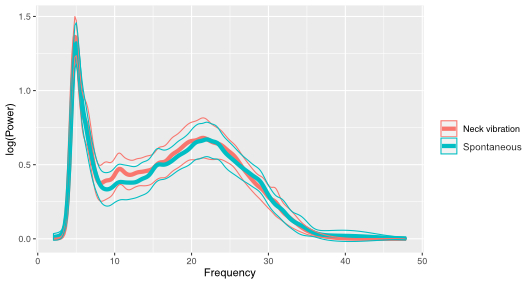Category: Dystonia: Pathophysiology, Imaging
Objective: The aim of the current study is to characterize changes in spontaneous pallidal neuronal activity during modulation of peripheral proprioceptive input by means of high frequency neck vibration.
Background: Cervical dystonia (CD) is the most common form of dystonia characterized by turning or tilting of the head, often combined with neck pain and rhythmic movements. Information regarding the brain regions that may be involved in CD is surprisingly limited and often conflicting. Although peripheral proprioception sensors are normal in dystonia, abnormal modulation of their output may lead to impaired movements in dystonia. Mechanistic underpinning, how proprioception modulates dystonia, and particularly what is the role of basal ganglia in this process is still unclear.
Method: We assessed 15 patients with CD who underwent implantation of DBS electrodes in globus pallidus (GPi). Spontaneous single-unit activity and LFP was recorded as the electrode was advanced through the pallidum. The spontaneous activity of each cell was recorded for at least 20 seconds, then we vibrated trapezius muscle, again measuring spontaneous single-unit activity for at least 20 seconds in presence of neck muscle vibration. We performed offline analysis of spiketrain parameters and spectral analysis of periodic and aperiodic component of LFP.
Results: We analyzed 58 GPi and 31 GPe cells activity. We found that neck vibration significantly reduces coefficient of variance and frequency variance of GPi neurons and frequency variance of GPe cells. Other parameters of GPe and GPi neurons were not influenced by high-frequency neck muscle vibration. Analysis of 94 LFP showed significant increase of alpha oscillations in GPi (Figure 1), which is shown to have cerebellar source. The differences of LFP activity in GPe were insignificant.
Conclusion: Our results support our central hypothesis that modulation of peripheral proprioceptive input changes the activity pattern of pallidal single neurons and LFP. The result also suggest that such proprioceptive modulation may occur via the cerebellar connections to the basal ganglia.
This study was supported by Russian Science Foundation (18-15-00009, Sedov), Dystonia Medical Research Foundation Grant (Shaikh), and partly by Russian Foundation for Basic Research (20-015-00438, Semenova).
To cite this abstract in AMA style:
A. Sedov, A. Gamaleya, U. Semenova, S. Usova, R. Medvednik, A. Tomskiy, H. Jinnah, A. Shaikh. High frequency neck vibration changes the pallidal activity in cervical dystonia [abstract]. Mov Disord. 2022; 37 (suppl 2). https://www.mdsabstracts.org/abstract/high-frequency-neck-vibration-changes-the-pallidal-activity-in-cervical-dystonia/. Accessed December 29, 2025.« Back to 2022 International Congress
MDS Abstracts - https://www.mdsabstracts.org/abstract/high-frequency-neck-vibration-changes-the-pallidal-activity-in-cervical-dystonia/

